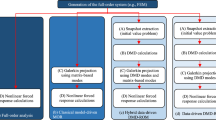Abstract
Model reduction has become very important in order to save calculation time. In particular, in structural dynamics, computations become very time-consuming when the critical time step of explicit integrators becomes very small. The main focus of this paper is on the application of the Proper Orthogonal Decomposition (POD) method to a structure subjected to transient earthquake loading. It is shown that based on the information of only a small portion of the transient excitation and the structure (“snapshots”), it is possible to assemble a reduced-order model, which yields a very accurate and time-saving approximation of the response to the entire earthquake. The POD reduction method is applied not only to linear, but also to nonlinear structures under earthquake loading. In the linear case, the POD results can be compared to those obtained by the classical method of modal truncation. In the nonlinear case, base isolation systems (friction pendulum systems) are integrated in the structure. Error estimations are applied in order to assess the solution of the POD-reduced system of the linear and the nonlinear systems. The POD can be applied successfully if the snapshots within the chosen time interval describe the main behavior of the system well. In both the linear and nonlinear cases, the approximation of the system as reduced by the POD is very accurate even if only a few POD modes are used. The advantage over the method of Modal Truncation is not only the optimality of the POD modes concerning their associated energy, but also its applicability to nonlinear systems.
Similar content being viewed by others
References
Bathe K.J.: Finite Element Procedures. 1st edn. Prentice Hall, New Jersey (1995)
Bienkiewicz B., Tamura Y., Ham H.J., Ueda H., Hibi K.: Proper orthogonal decomposition and reconstruction of multi-channel roof pressure. Wind Eng. Indust. Aerodyn. 54-55, 369–381 (1995)
Bronstein I., Semendjajew K., Musiol G., Mühlig H.: Taschenbuch der Mathematik. Harri Deutsch, Zürich (2001)
Bucher C.: Stabilization of explicit time integration by modal reduction. In: Wall, W.A., Bletzinger, K.U., Schweizerhof, K. (eds) Trends in Computational Structural Mechanics, pp. 429–437. CIMNE, Spain (2001)
Bucher C.: Probability-based optimal design of friction-based seismic isolation devices. Struct. Safety 31, 500–507 (2009)
Chatterjee A.: An introduction to the proper orthogonal decomposition. Curr. Sci. 78(7), 808–817 (2000)
Chopra A.K.: Dynamics of Structures, Theory and Applications to Earthquake Engineering. 2nd edn. Prentice Hall, New Jersey (2001)
Cusumano J., Sharkady M., Kimble B.: Spatial coherence measurements of a chaotic flexible-beam impact oscillator. Am. Soc. Mech. Eng. Aerospace Div. (Publication) AD 33, 13–22 (1993)
Feeny B.F., Kappagantu R.: On the physical interpretation of proper orthogonal modes in vibrations. J. Sound Vib. 211(4), 607–616 (1998)
Geschwindner L.F.: Nonlinear dynamic analysis by modal superposition. J. Struct. Div. 107(12), 2325–2336 (1981)
Holmes P., Lumley J.L., Berkooz G.: Turbulence, Coherent Structures, Dynamical Systems and Symmetry. Cambridge University Press, Cambridge (1996)
Kappagantu R., Feeny B.: An “optimal” modal reduction of a system with frictional excitation. J. Sound Vib. 224(5), 863–877 (1999)
Kappagantu R., Feeny B.: Part 1: Dynamical characterization of a frictionally excited beam. Nonlinar Dyn. 22, 317–333 (2000a)
Kappagantu R., Feeny B.: Part 2: Proper orthogonal modal modeling of a frictionally excited beam. Nonlinear Dyn. 23, 1–11 (2000b)
Kerschen G., Golinval J.C.: Physical interpretation of the proper orthogonal modes using the singular value decomposition. J. Sound Vib. 249(5), 849–865 (2002)
Kerschen G., Golinval J.C.: A model updating strategy of non-linear vibrating structures. Int. J. Numer. Methods Eng. 60, 2147–2164 (2003)
Kikitsu H., Okuda Y., Ohashi M., Kanda J.: Pod analysis of wind velocity field in the wake region behind vibrating three-dimensional square prism. Wind Eng. Indust. Aerodyn. 96, 2093–2103 (2008)
Liang Y.C., Lee H.P., Lim S.P., Lin W.Z., Lee K.H., Wu C.G.: Proper orthogonal decomposition and its applications—part 1: theory. J. Sound Vib. 252(3), 527–544 (2002)
Nicholson D.: On stable numerical integration methods of maximum time step. Acta Mechanica 38, 191–198 (1981)
Qu Z.Q.: Model Order Reduction Techniques with Application in Finite Element Analysis. Springer-Verlag London Limited, London (2004)
Rega G., Troga H.: Dimension reduction of dynamical systems: methods, dimension reduction of dynamical systems: methods, models, applications. Nonlinar Dyn. 41(1), 1–15 (2005)
Ritto, T., Buezas, F., Sampaio, R.: A new measure of efficiency for model reduction: application to a vibroimpact system. J. Sound Vib. 1977–1984 (2010)
Tubino F., Carassale L., Solari G.: Seismic response of multi-supported structures by proper orthogonal decomposition. Earthq. Eng. Struct. Dyn. 32, 1639–1654 (2003)
Volkwein, S.: Model Reduction Using Proper Orthogonal Decomposition. Karl-Franzens-Universitaet Graz, Institut für Mathematik und Wissenschaftliches Rechnen (2008a)
Volkwein, S.: Proper Orthogonal Decomposition and Singular Value Decomposition. Karl-Franzens-Universitaet Graz, Institut für Mathematik und Wissenschaftliches Rechnen (2008b)
Wang L., Wang Y., L Z., Zhang Y.: Estimation of the vortex shedding frequency of a 2-d building using correlation and the pod methods. Wind Eng. Indust. Aerodyn. 98, 895–902 (2010)
Author information
Authors and Affiliations
Corresponding author
Rights and permissions
About this article
Cite this article
Bamer, F., Bucher, C. Application of the proper orthogonal decomposition for linear and nonlinear structures under transient excitations. Acta Mech 223, 2549–2563 (2012). https://doi.org/10.1007/s00707-012-0726-9
Received:
Revised:
Published:
Issue Date:
DOI: https://doi.org/10.1007/s00707-012-0726-9




